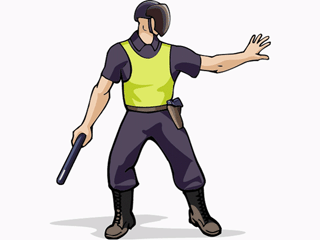 |
 |
|
August 2005 |
Hi Tech Criminal Justice Newsletter
Terrorism and Technology
|
| |
Dear Raymond,
The Hi Tech Criminal Justice newsletter continues to grow with
nearly 1000 subscribers. Our growing readership has help attract a
number of first-rate contributing writers. Last month we introduced
Todd Brown who continues with his series of articles looking at the
intersection of police training and technology. In this issue, we
introduce Jimmy Lee Shreeve, a London-based correspondent who has
provided us with an excellent primer on Cybercrime.
The lead article begins a two-part series analyzing police officer
casualties in the War Against Terror. In the next issue this series
will conclude with a look at technology, counter terrorism and local
law enforcement. Our final two articles take you off-site to the
National Institute for Justice and National Commission on the Future
of DNA Evidence. |
|
 |
Counterterrorism Tactics for Police Officers |
|
|
Lieutenant Raymond E. Foster, LAPD (ret.) |
|
Police officer fatalities mount world-wide

The data from outside the US indicates that police officers are
specifically targeted by terrorists. Like the US, many countries rely on
internal police organizations to pursue criminal investigations against
terrorists. Police officers are on the front line in the War Against
Terror as they make arrests, guard critical facilities and respond to
the scenes of terrorist acts.
A close look at terrorist incidents involving police officers reveals
that fatalities and casualties have several commonalities. An in-depth
analysis of the data on attacks against police officers has led to
several recommendations concerning counterterrorism tactics and training
for local police officers.
|
 |
Cyber Sleuths |
|
|
Jimmy Lee Shreeve, Contributing Writer |
|
Computer forensic analysts - the consulting detectives of the digital
world - are in big demand as computer-related evidence proves increasingly
critical in solving crimes.

In the days of Raymond Chandler's wise-cracking sleuth Philip Marlowe,
the proverbial "smoking gun" was a trail of physical evidence. Now, due
to the proliferation of computers, mobile phones, PDAs and lately iPods,
that trail often includes a good deal of digital evidence. Sometimes a
deleted e-mail or Internet bookmark, retrieved by experts from the hard
drive, is the key to getting a conviction.
In South Dakota in 1999, for example, a woman was found drowned in
her bath. An autopsy showed a high level of the sleeping pill Temazepan
in her bloodstream. It looked like a typical suicide - until
investigators took a close look at her husband's computer. It turned out
he had been researching painless killing methods on the Internet and
taking notes on sleeping pills and household cleaners. Armed with that
evidence prosecutors were eventually able to put him behind bars.
|
 |
TASER® Guidelines |
|
|
Todd Brown, Contributing Writer |
|
10 guidelines for use of TASERs® in simulated training environments

The use of TASER® conducted energy weapons in law enforcement has
increased dramatically over the last few years. The less-lethal weapons
have proven effective in a variety of situations and their use has been
credited with saving many lives, In many cases if the TASER devices
weren't effective the only alternative left to the officer would have
been lethal force. To say that the statistics estimating saved lives,
reductions in injuries and cost savings to agencies resulting from TASER
use is impressive would be a gross understatement
|
 |
What Every Officer Should Know About DNA Evidence |
|
| |
|
Best practices for identification, preservation, and collection of DNA
evidence at the crime scene
The National Commission on the Future of DNA Evidences Crime Scene
Investigation Working Group has developed two interactive modules of
instruction on the identification, preservation and collection of DNA
evidence at crime scenes.
The Beginning Module focuses on the first-responding law enforcement
officer and the Advanced Level delivers more in-depth information for
the detective and/or evidence technician.
|
 |
Without a Trace? |
|
| |
|
Advances in detecting trace evidence

Currently, law enforcement has no accurate way to match the glass shards
or coated hair to known samples, and locating tiny particles of
explosive material or body fluids might be difficult or impossible. But
all thats about to change as new and improved techniques for detecting
and distinguishing trace evidenceminute quantities of materials such as
blood, chemicals, fibers, glass, hair, plant material, or plasticsare
very close to being added to the law enforcement arsenal.
Connecting a person or object to a specific crime scene is often
essential to proving guilt or innocence. Developing such a link is
frequently based on identifying and comparing trace evidence. Because
trace evidence samples can look similar and the environments where they
are found are often complex, identifying unique characteristics and
establishing a link can be difficult. Older techniques often cannot
distinguish such evidence due to these challenges. New technologies for
trace evidence may help eliminate many of these obstacles, allowing more
trace evidence to be found and identified.
|
| |
 |
|
Contact Information
phone: 909 599 7530
|
|
